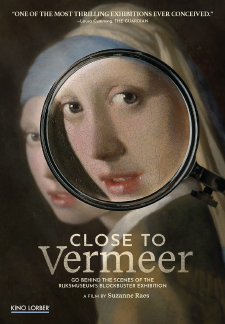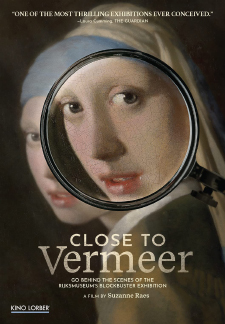Close to Vermeer (DVD Review)

Director
Suzanna RaesRelease Date(s)
2023 (July 11, 2023)Studio(s)
Docmakers/NTR/NTR Television (Kino Lorber)- Film/Program Grade: A
- Video Grade: A
- Audio Grade: A
- Extras Grade: B-
Review
As documentaries go, director Suzanne Raes’s Close to Vermeer (2023) is just about perfect. An in-depth, behind-the-scenes look at preparations for a landmark exhibition of works by Dutch Baroque period painter Johannes Vermeer (1632-1675), its viewers need not be familiar with the artist or even art generally. The film concisely and intriguingly describes just what make Vermeer’s works so uniquely special and why, even now, very little is known about this enigmatic artist.
At the same time, the level of deep, heartfelt emotions expressed by Vermeer experts and researchers is contagious—the movie audience quickly gets caught up in the excitement of new discoveries and conflicting opinions about the authenticity of disputed works. It demonstrates the logistical challenges of staging such an exhibition, and how tiny considerations and adjustments can make all the difference. We learn how rapidly advancing technologies are helping researchers better understand works by Vermeer and other artists. As someone pretty ambivalent toward Dutch Golden Age art, I found the film utterly engrossing from its opening moments and its 79 minutes whizzed by at lightning speed. I didn’t want it to end.
Vermeer makes for a particularly interest subject: only 34 paintings survive that are universally attributed to him, and the circumstances and order in which they were painted is largely unknown. Unlike his contemporary Rembrandt, Vermeer did no self-portraits (except for one painting showing him from behind), and his paintings were comparatively tiny for the period, too small to have earned him much money in his lifetime. (One is reminded of the antisocial artist played by Max von Sydow in Woody Allen’s Hannah and Her Sisters: “I do not sell my work by the yard!”)
The film revolves around a 2023 exhibition by the Rijksmuseum in Amsterdam that attempts to bring together as many of these 34 paintings as possible, some of which have resided in England, Germany, the U.S. and other countries for centuries. Beyond the desire of bringing these works “home,” its organizers emphasize that it’s not so much the unprecedented number of paintings that’s important, but rather the significance in allowing people to be able to view most of his work all at once, to be able to compare them to one another, and to see Vermeer’s evolution as an artist.
At the center of this story are two aging Vermeer experts: Gregor J.M. Weber and Johnathan Janson, both on the cusp of retirement who see the Vermeer exhibition as a kind of Last Hurrah. Dignified and eloquent, they nonetheless struggle to maintain their composure when speaking about the profound impact Vermeer’s paintings have had on their lives. Janson talks of seeing his first Vermeer as a teenager, his last when he was about 70. When Weber locates a painting (by another artist) that Vermeer himself had included in the background of one of his own painting, Janson is astounded that Weber could locate it, since only one small part of it is visible in the Vermeer. “Can I... touch it?” Janson asked, barely able to contain his excitement. Wach struggles to express the impact the artist has had on their lives without weeping.
They along dapperly-dressed Pieter Roelofs, clearly the diplomat of the group, have to contend with various museums around the world for the loan of their Vermeers. The curators and archivists are polite and professional but clearly reluctant in some cases to loan out their irreplaceable holdings. There’s also the single private owner of a Vermeer, a multi-millionaire (billionaire?) clearly not on the same appreciative wavelength as Weber and Janson, but to whom they have to treat as if he were. (At another point in the film someone says, roughly, “Rich people are great because they’ll die soon and their paintings invariably wind up in public museums.”)
The dramatic highlight comes when American researchers present a study they believe conclusively proves one painting, “Girl with a Flute,” was not painted by Vermeer. Weber and Janson, among others, dispute these findings, and want to include it in the exhibition anyway, as a genuine Vermeer. In the aftermath of the meeting, everyone is polite and cordial to one another, but the undercurrent of tension is palpable. This may not sound like the stuff of nail-biting drama but, in a way, it is exactly that.
Apparently shot digitally in high-def, Close to Vermeer is presented on DVD in 16:9 enhanced widescreen (full screen 1.78:1). One longs for a 4K or Blu-ray release given all the close-ups of Vermeer paintings, but the DVD does a decent job given its standard-def limitations. Mostly in English and Dutch, audio is offered in both 5.1 surround and 2.0 stereo mixes, both excellent, as are the English subtitles. Region 1 locked.
Extras include 9:33 of deleted scenes and a trailer.
Naturally admirers of Vermeer will love this film, but so too will even those with an ambivalent attitude toward art generally. I have an early 18th painting, a kind of family heirloom, tucked safely away in storage that I hadn’t thought about much until about midway through Close to Vermeer. I think I’ll go look at it now, maybe even hang it on a wall. One thing’s for sure—after seeing Raes’s film, I’ll be looking at it in an entirely new light.
- Stuart Galbraith IV

